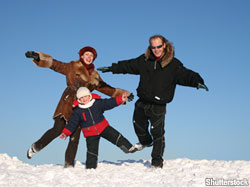
(ARA) – From grandparents to grade-schoolers, we’ve almost all, on occasion, sacrificed sensible for stylish when it comes to the shoes we select for cold-weather wear.
But wearing shoes that don’t protect and support our feet during chilly winter months can cause foot ailments that could last long after the snow has melted into spring. From bunions, dry skin and toenail fungus to frostbite and arthritis, cold can cause and worsen a range of foot health problems.
To every shoe its season, says the American Medical Podiatric Association (APMA).
“Sixty-four percent of Americans admit to wearing shoes that hurt their feet, and three out of 10 who wear painful shoes say they do it at least once a week,” notes Dr. Kathleen Stone, podiatrist and president of the APMA. “We generally spend a lot of time on our feet, and nearly a quarter of us put in six or more hours on our feet each day. Winter, with its precipitation and chilly temperatures, not to mention the demands of the holidays, is no time to live with feet that hurt.”
The APMA offers some winter foot health fixes for the holidays and winter months:
Choose the right footwear
It may seem obvious that when temperatures dip, you shouldn’t don footwear that’s more appropriate for fun in the sun. But almost all of us have seen someone wearing sneakers in the snow or high heels in the rain.
When there’s no precipitation in the air or on the ground, a good, sturdy, comfortable shoe is fine. But when the weather turns nasty, you need quality boots to protect your feet. When buying boots keep this advice in mind for all your favorite styles:
* Riding boots – Avoid synthetic materials that trap heat and moisture, which can cause odor or, worse, fungal infections. Opt for natural materials like leather that allow proper airflow and keep your feet dry.
* Weather boots – Soften rigid rain boots with cushioned insoles and supports. Rigid footwear limits natural foot movement and provides no arch support. Make sure snow boots have rubber soles with deep groves for proper traction.
* Trendy boots – Ankle booties are back (you may remember them from the ’80s) in style, but they lack ankle support and often have high heels that can cause imbalance. Choose a heel no higher than 2 inches and don’t walk long distances in your trendy ankle boots. Likewise, classic cowboy boots are not made for walking; the narrow toebox can cause blisters and cramped toes. Boots that are narrow and that have very high heels transfer weight onto the ball of your foot and can cause numbness or pain. Lower or stacked heels will provide more support.
General foot health tips for winter
You’ll be on your feet a lot throughout the holiday season. It pays to take care of your feet, and it’s hard to get into the holiday spirit when your feet hurt. Fortunately, there are ways to help your feet feel their best all year-round:
* Simple exercises can help avoid painful cramping. Raise, point and curl your toes for five seconds on each foot. Repeat 10 times. Rotate your ankles to relax your feet. Cup your heel and rotate each ankle slowly five times. This helps loosen ankle joints.
* Massage your feet; it releases tension, promotes circulation and rejuvenates the skin after a long day of walking and standing. Add your favorite scented lotion into the mix for a soothing, relaxing experience.
* Elevate your legs. If you’re prone to swollen ankles or calves and you sit a lot at work, elevate your legs with a foot stool under your desk. At the end of the day, reduce swelling by lying down and lifting your legs above your heart.
If you overdo it and experience chronic foot pain, a podiatrist – the foot and ankle expert – can help. To find a podiatrist, and learn more about today’s podiatrist, visit www.todayspodiatrist.com, or visit the APMA’s website at www.apma.org.





